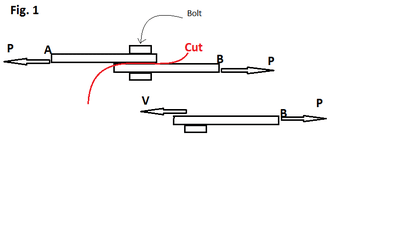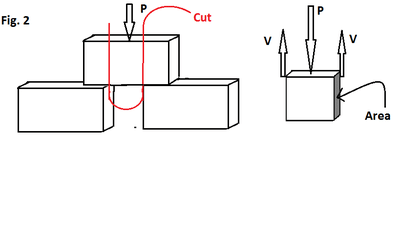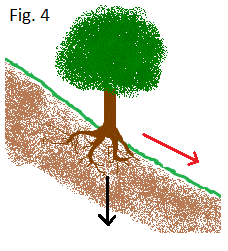Audience 1: Engineering 213 Students
Shear stress is the amount of shear force per unit area over a cross section. It is defined by the equation \tau= V/A where V is the shear force and A is the cross-sectional area parallel to the shear force vector. Direct shear stress is shear stress which is caused from an applied force, rather than from a torque. Shear stress is important because it is often the cause of mechanical failures in all sorts of connections such as pins, bolts, and hinges.
(here are the diagrams for this one)
Fig. 1 is a simple bolt connection between members A and B.
After the cut, the internal forces are exposed and it is clear that the shear force (V) is equal to P.
Fig. 2 is an example of what is called “double shear”. After the internal forces are exposed we find that there are two locations where shear force is present. By using our equations for static equilibrium (there was a sum of forces in the y = 0 here), we find that 2V=P or V=1/2P. The term “double shear” comes from the fact that shear stress is present in two locations.
Audience 2: Business Manager
In order to understand direct shear stress we must first understand what shear force is. Shear force is the action which causes two sections of a material to slide over one another. Try rubbing your hands together. The friction between your palms makes it necessary to push one hand alongside the other. This “push” is what is called a force in physics. The word shear describes the direction of the force being parallel to the surfaces which want to slide against each other. In this case the shear force takes place between your two hands, but it can also happen inside of a solid object and cause it to “slip” into two separate pieces.
Direct shear stress is simply the amount of shear force per unit of area. When you rubbed your hands together the area would refer to the area of your palm. Shear stress is an important topic because it can cause breakage or mechanical failure in many sorts of connections, such as bolts and hinges. For example, the bolt in fig. 3 will break if the pull on the connection is too great. Because shear stress is inversely proportional to area, we can increase the size of the bolt to prevent it from breaking.
Fig. 3 is a simple bolt connection. The arrows represent something pulling on both sides of the connection. The figure indicates where shear stress is present at, this point the bolt wants to split in two directions.
Fig. 4 shows a tree on a slope. The black arrow represents the weight of the tree pushing straight down. Because the tree is on a slope a portion of its weight is directed down the hill, this is represented by the red arrow. The red arrow is a shear force, as it is parallel to the hill. This tree is experiencing a shear stress, if its roots are not strong enough, or the shear force is too great, then the tree will give way and slide down the hill.







